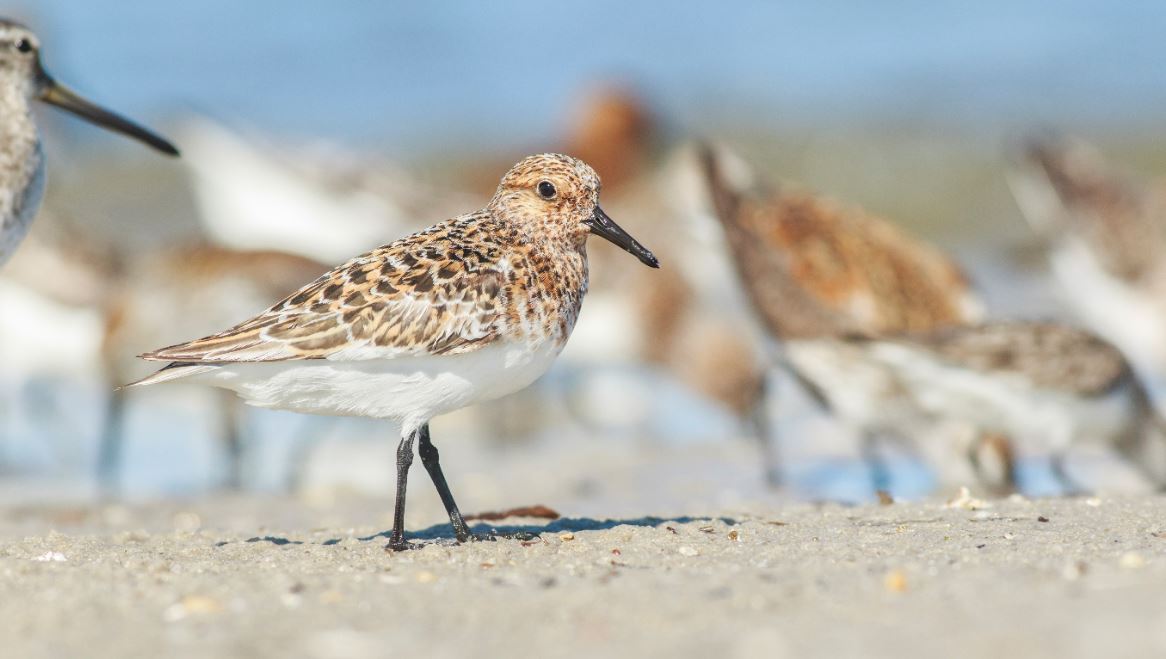Each May, DNREC’s Delaware Shorebird Project carries out its research objectives during the shorebirds’ stopover in the Bay. The brief field season brings long, but rewarding, days on the coast.
Each year, flocks of shorebirds are carefully counted and individually marked birds recorded at sites along the Delaware Bay. The data provide insight into shorebird longevity, habitat use, and population health and size. The data is published in peer reviewed scientific publications, conservation plans and management reports. This information helps identify and protect the resources critical to successful shorebird migration in Delaware, and our research contributes to an international shorebird network.
As well as the many volunteers who have assisted on the Delaware Shorebird Project, the Division of Fish and Wildlife partners with the British Trust for Ornithology and Wash Wader Ringing Group, the US. Fish and Wildlife Service (USFWS) including the USFWS Delaware Bay Estuary Project and Prime Hook/Bombay Hook National Wildlife Refuge staff, Delaware Museum of Natural History and Delaware National Estuarine Research Reserve (DNERR).

Several times during the season, the team conducts a carefully monitored catch using cannon nets to capture shorebirds.
During their brief time under the team’s care, shorebirds are banded with a metal band etched with a unique number. If that bird is caught again, the ID number can be used to track when and where the bird was originally banded.
Some shorebirds also receive a leg flag with a readable code which can be read through a spotting scope or camera. These birds are measured, aged, and weighed before release.
With help from volunteers, biologists have banded more than 60,000 shorebirds along the Delaware Bay since 1997. Marking birds with individually coded leg flags has led to a growing database of sightings. These describe migration routes and timing, stopover duration and other important information. Data collected helps identify shorebird health and condition as well as where they spend the non-breeding season.
The ability of birds to gain weight throughout the season is critical to our understanding of the conditions these shorebirds encounter on the Delaware Bay. Novel approaches to analyzing seasonal data are used to assess the birds’ ability to put on weight (energy reserves) while they are here.
Shorebirds, particularly Red Knots, are long-lived species with long-distance migratory patterns. Given these characteristics, a variety of factors may impact their populations either positively or negatively. These characteristics limit our ability to accurately determine and monitor their overall population size. We can, however, assess year-to-year survivorship to help monitor their populations. Survivorship is assessed through resighting individually marked birds in subsequent years.

Much of the data collected by the Delaware Shorebird Project comes from resighting flagged birds. At site surveys, flocks of birds are scanned for colored leg flags using binoculars, spotting scopes or cameras. The species, flag color, and flag code are recorded. The color alone can tell us what country the bird was initially caught and flagged in. Later, in collaboration with partners throughout the species range, the code can be used to identify a date and exact location. This data has allowed us to identify stop over duration, movement within the bay, habitat use, and survival of the shorebirds.
Monitoring the Delaware Bay passage requires knowledge of how long birds stay in the Bay as well as arrival and departure patterns. It is not sufficient to assume that all birds get to Delaware Bay on May 1 and depart on May 28. There are observable differences in the arrival of different groups of birds. Knowing when these events happen will potentially allow us to better assess how different populations of shorebirds are using the Bay. Stopover duration is assessed through resighting of flagged birds.
Determining where birds go in the Delaware Bay during their stopover is a critical part of directing conservation and protection efforts. Resighting flagged birds at various locations throughout the Bay is one method used to evaluate Bay-wide movement patterns.
Advances in technology have allowed us to use other methods such as automated radio tracking systems to extend the scope of “resighting” birds both by location and through time. This system has been used to track Red Knot movement patterns by attaching radio transmitters to a small group of individuals, allowing us to track their movements almost continuously during their stopover.
Molecular analysis of Red Knot feathers collected in Delaware Bay has revealed four distinct wintering areas: Bahia Lomas, Chile; Rio Grande, Argentina; Southeast U.S. (FL and GA); and Northern Brazil/Caribbean.
There may be important fitness and survivorship consequences for Red Knots depending on where they spend the winter. This work is ongoing and the results will ultimately be compared to survivorship estimates for wintering groups, arrival/departure dates, movement patterns, and weight gain.
2025 Rufa Red Knot Delaware Bay Aerial Survey Annual Report
New Jersey Fish and Wildlife Delaware, DNREC Division of Fish and Wildlife, U.S. Fish and Wildlife Service
September 2025
Lyons, J.E. 2024. Red Knot stopover population size and migration ecology at Delaware Bay, USA, 2023. Delaware Division of Fish and Wildlife, Dover, DE.
Lyons, J.E. 2023. Red Knot stopover population size and migration ecology at Delaware Bay, USA, 2023. Delaware Division of Fish and Wildlife, Dover, DE.
Lyons, J.E. 2022. Red Knot stopover population size and migration ecology at Delaware Bay, USA, 2022. Delaware Division of Fish and Wildlife, Dover, DE.
Lyons, J.E. 2021. Red Knot stopover population size and migration ecology at Delaware Bay, USA, 2021. Delaware Division of Fish and Wildlife, Dover, DE.
Related Topics: birds, conservation, delaware bay, fish and wildlife, red knots, shorebirds, wildlife